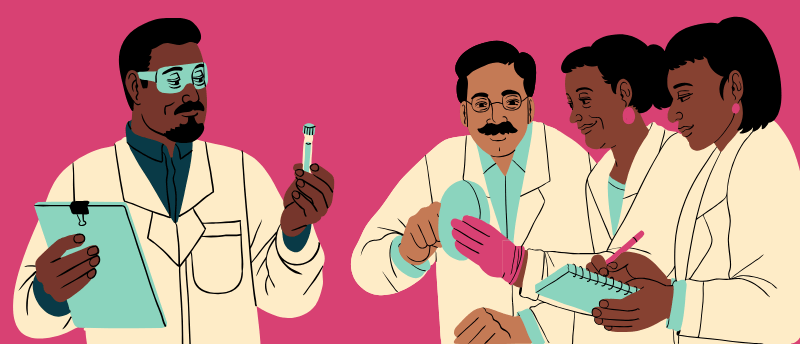Black scientists’ contributions to research throughout history

This Black History Month, we’re recognizing Black scientists’ contributions to developmental biology, disease research, plasma storage and imaging techniques.
For more information about the following scientists, explore the resource list below.
Ernest Everett Just: offering insights into embryology (1883–1941)
Ernest Everett Just was an experimental embryologist, who conducted simple – yet elegant – experiments on marine invertebrates to demonstrate that the egg surface, or ectoplasm, plays a key role in fertilization and development [1].
Although born in 1883 in Charleston, South Carolina (USA), Just grew up on James Island off the coast of South Carolina, where his mother founded and directed a school. An avid learner, Just attended his mother’s school until age 13 when he left James Island to attend the Colored Normal Industrial Agricultural and Mechanics College at Orangeburg (now South Carolina State College; SC, USA) [2]. He graduated at 15 with a Licentiate of Instruction, which qualified him to teach in any Black school in South Carolina. However, Just’s passion did not lie in teaching; instead, he enrolled at Dartmouth College (NH, USA) to study biology, literature and history. After graduating magna cum laude, Just joined the English faculty at Howard University (Washington DC, USA) before being asked to also head the biology department. He soon gave up teaching English to become the head of the zoology department. However, Just’s desire to pursue further learning led him to obtain a PhD from the University of Chicago (IL, USA) and conduct research at the Marine Biology Laboratory at Woods Hole (MA, USA), while retaining his teaching position at Howard [1].
Just’s research focus was on marine invertebrate eggs, creating a laboratory environment that closely mimicked their natural habitats. He is responsible for the discovery of many egg–sperm interaction characteristics, such as the time it takes for a sperm to penetrate the egg membrane, the egg’s role in pulling sperm in and the wave of instability that follows sperm penetration, which blocks any other sperm from penetrating the egg. He also discovered that marine worm eggs cleave in different planes depending on the arbitrary location of sperm penetration, combatting preformationist theory [1, 3].
Ruth Ella Moore: inspiring the next generation of scientists (1903–1994)
Ruth Ella Moore was a trailblazer. She was the first Black individual to receive a PhD in microbiology; she was also the first Black individual to join the American Society for Microbiology. Her bacteriological studies of tuberculosis contributed to eradicating the disease [1].
Ruth attended Ohio State University (OSU; OH, USA), in her home state, for both her bachelor’s and master’s in science degrees. She then taught at Tennessee State College (TN, USA) to save money for further study. She returned to OSU to obtain her PhD in bacteriology, which she completed in 1933, making her the first Black woman to earn a PhD in the natural sciences. It was during her PhD that Moore researched tuberculosis, the findings from which would contribute to its eventual eradication. She then moved into a teaching role at Howard University Medical School, where she oversaw the rebuilding of the pre-clinical division. When the head of the bacteriology department entered military service in 1945, Moore took over the department and was acting Head until 1955 and Head until 1960, making her the first female head of a department at Howard. After stepping down from Head, Moore continued her professorship until 1971 [1].
Throughout her career, she not only helped to eradicate tuberculosis, but she also detailed the prevalence of different blood types among African Americans and characterized gut microorganisms’ reactions to different antibiotics [2].

STEM Tea | Empowering youth, empowering communities: on a mission to decolonize knowledge
In this episode of the STEM Tea podcast, Alhaji N’jai and AJ Hinton discuss Project1808, an organization that forms partnerships with universities to foster community development through education.
Charles Richard Drew: father of the blood bank (1904–1950)
Charles Richard Drew was an American surgeon renowned for his long-term storage method for blood plasma, a discovery that would save thousands during World War II and lead to the establishment of America’s first large-scale blood bank [1].
Drew grew up in Washington DC (USA) before being awarded an athletic scholarship for football and track and field by Amherst College (MA, USA). Drew wasn’t sure what direction his life would take after university until his biology professor encouraged him to consider medicine, a field that – like many others – was heavily segregated, limiting his options. He attended McGill University College of Medicine (Montréal, Canada), where he was awarded a scholarship prize in neuroanatomy and the J. Francis Williams Prize in medicine after beating the top five students in an exam competition. He graduated second in his class of 137 in 1933 with both MD and Master of Surgery degrees. Drew went on to complete his surgical residency at Montreal Hospital, where he first became interested in transfusion medicine while working alongside bacteriology professor John Beattie as they developed ways to treat shock with fluid replacement. After a few years of teaching, Drew pursued a doctorate degree at Columbia University (NY, USA), during which he won a fellowship to train at Presbyterian Hospital (NY, USA). Here, he worked under John Scudder, who had received funding to set up a blood bank, and focused his research on blood chemistry, preservation and transfusion [1, 2].
His research eventually led him to be appointed head of the Blood for Britain Project, an effort to send blood and plasma to Britain during World War II, which he led successfully. His method involved separating plasma from blood cells via centrifugation and sedimentation before collecting the plasma using anti-contamination techniques that involved strict air and ultraviolet lighting conditions. Samples of plasma were cultured to check for bacteria, and each week the plasma stores were treated with Merthiolate, an antibacterial. Before sending the plasma, sterile saline solution was added to the shipping containers. Over the course of the project, they collected 14,556 blood donations – in part thanks to bloodmobiles, mobile blood donation stations [2] – and shipped 5000 liters of plasma saline solution to the UK [1].
Marie Maynard Daly: linking atherosclerosis, aging and high blood pressure (1921–2003)
Marie Maynard Daly contributed significantly to research into biochemical and molecular processes, from demonstrating RNA’s essential role in protein production to investigating heart attacks, cholesterol and the effects of smoking on lung health [1].
Daly grew up in New York, where she attended Hunter College High School for gifted girls. She pursued her education with vigor, inspired by her favorite book, Microbe Hunters. The school was unique due to its diversity and all-female faculty, which facilitated and encouraged learning in subjects like science, mathematics and medicine. Daly credited the school for her doubtless pursuit of a career in science. Next, she attended Queens College (NY, USA) and graduated with a bachelor’s degree in chemistry. She didn’t stop there; despite the limited acceptance of women to graduate programs, New York University (NYU; NY, USA) began accepting women in 1943, when fewer men were enrolling due to World War II. She received her master’s degree from NYU while also teaching chemistry at Queens College. In the summer of 1944, Daly was accepted to Columbia University’s chemistry PhD program, where she worked with Mary Letitia Caldwell – a diligent enzymologist researching amylases and the only female faculty member in the department. Three years and one PhD later, Daly was awarded an American Cancer Society grant, which funded a post-graduate research position at Rockefeller University (NY, USA) working with Alfred Mirsky, one of the foremost geneticists of the time. It was here that Daly researched protein architecture and production [1].
A career pivot saw Daly investigating medical research questions back at Columbia University, in their College of Physicians and Surgeons. She and her team used rat models to explore the links between atherosclerosis, aging and high blood pressure, which led to a breakthrough finding that those with history of hypertension have an increased risk of heart attack [1].

Cancer disparities: shifting the scales on underrepresentation in science
We speak to Camille Ragin about her research into the disparities found in cancer and the work of the African-Caribbean Cancer Consortium that she founded almost 20 years ago.
Jewel Plummer Cobb: conducting foundational research in melanoma (1924–2017)
Jewel Plummer Cobb was a cancer researcher who investigated how hormones, ultraviolet light and chemotherapeutic drugs can cause changes in cell division. She was also an influential figure, encouraging more women and individuals from underrepresented backgrounds to pursue STEM careers [1].
Cobb was born and raised in Chicago (IL, USA) to parents who encouraged her education in science and mathematics. After using a microscope for the first time as a sophomore in high school, Cobb was hooked on biology. She attended the University of Michigan (MI, USA) for three semesters before transferring to Talladega College (AL, USA), a historically Black college, due to racially segregated housing and social exclusion. Cobb’s educational journey continued at NYU, where she earned a PhD in cell physiology in 1950. It was during her PhD that Cobb developed her lifelong interest in melanin and skin cancer. Her dissertation detailed her characterization of tyrosine, an enzyme required for melanin production, and its use in producing melanin in the lab. She would go on to demonstrate that deeper melanin pigmentation protects skin cells from X-ray exposure, which was the first indication that melanin has a protective quality against harmful UV radiation [1, 2].
After graduating, Cobb accepted three postdoctoral research positions at Columbia University, the National Cancer Institute (MD, USA) and the National Cancer Institute at Harlem Hospital (NY, USA). At the National Cancer Institute at Harlem Hospital, she collaborated with oncologist Jane Wright and honed her tissue culturing skills, both of which would prove central to her career. In 1952, Cobb founded her own lab at the University of Illinois Medical School (IL, USA), where she established a tissue culture facility. She then returned to Harlem Hospital to work with Wright, who was studying the effects of chemotherapy on cancer patients; Cobb started investigating the effects of chemotherapy on tissue cultures sampled from patient tumors [1, 2].
Together, Cobb and Wright demonstrated the efficacy of methotrexate against skin and lung cancer and childhood leukemia. The drug is now widely used to treat a range of cancers, including breast cancer. Beyond her scientific achievements, Cobb was appointed to the National Science Board and helped form the first iteration of the National Science Foundation’s Committee on Women and Minorities in Science. She also chaired the first Conference for Minority Women Scientists in 1975, which produced a highly influential report to insight meaningful change [1].
George Edward Alcorn: inventing the X-ray imaging spectrometer (1940–2024)
George Edward Alcorn invented the X-ray spectrometer, a technology that focuses a beam of charged atoms on a sample to more accurately separate and identify the elements within a substance, in 1982 [1].
A Hoosier, Alcorn was born and raised in Indianapolis (IN, USA), where he developed a love of science from his father, a car mechanic. He attended Occidental College (CA, USA), graduating in 1962 with a bachelor’s degree in physics, before obtaining a master’s in nuclear physics in 1963 and a PhD in atomic and molecular physics in 1967 from Howard University. Alcorn then transitioned to industry, working with IBM (NY, USA) on high-performance semiconductors before joining NASA Goddard Space Flight Center (MD, USA) in 1978 [1].
It was at NASA that Alcorn invented the X-ray imaging spectrometer, as well as several other technologies, granting him eight patents [2]. His technologies have had a significant impact on the space industry, contributing to planetary mapping, the search for new planets, star-chart creation to explore motions of systems and the examination of deep space phenomena. Alongside his work at NASA, Alcorn taught at Howard University and the University of the District of Columbia (Washington DC, USA), where he supported doctoral candidates from underrepresented backgrounds. To extend his teaching and mentoring further, he set up Saturday Academy, a weekend math and science program for inner-city middle school students [1].
Alcorn died in June 2024, leaving behind a legacy of innovation and curiosity in science: “The big thing about being in science and engineering is that if you have a good, interesting project going, work is not coming to work, it’s coming to an adventure.”
Ernest Everett Just
- Arizona State University, Karen Wellner. Ernest Everett Just (1883-1941), Embryo Project Encyclopedia. [Accessed: 23 January 2025].
- Crow JF. Just and unjust: E. E. Just (1883–1941). <i>Genetics</i> 179(4), 1735–1740 (2008).
- Marine Biological Laboratory. Ernest Everett Just. [Accessed: 23 January 2025].
Ruth Ella Moore
- EOScu, Erica Mitchell. American Medical Hero: Dr. Ruth E. Moore. [Accessed: 23 January 2025].
- The Ohio State University, Misti Crane. Proud they’re ours: Ruth Ella Moore. [Accessed: 23 January 2025].
Charles Richard Drew
Marie Maynard Daly
Jewel Plummer Cobb
- Marine Biological Laboratory. Jewel Plummer Cobb. [Accessed: 30 January 2025].
- Finley SD. Jewel Plummer Cobb: A trailblazing life of impact. <i>Curr. Biol.</i> 34(24), pR1205-R1211 (2024).
George Edward Alcorn





